Difference between revisions of "Sclerocactus papyracanthus"
Bradleya 5: 94. 1987.
FNA>Volume Importer |
imported>Volume Importer |
||
| (2 intermediate revisions by 2 users not shown) | |||
| Line 8: | Line 8: | ||
}} | }} | ||
|common_names=Grama-grass cactus;paper-spined cactus;toumeya | |common_names=Grama-grass cactus;paper-spined cactus;toumeya | ||
| + | |special_status={{Treatment/ID/Special_status | ||
| + | |code=F | ||
| + | |label=Illustrated | ||
| + | }}{{Treatment/ID/Special_status | ||
| + | |code=E | ||
| + | |label=Endemic | ||
| + | }} | ||
|basionyms={{Treatment/ID/Basionym | |basionyms={{Treatment/ID/Basionym | ||
|name=Mammillaria papyracantha | |name=Mammillaria papyracantha | ||
| Line 60: | Line 67: | ||
|publication title=Bradleya | |publication title=Bradleya | ||
|publication year=1987 | |publication year=1987 | ||
| − | |special status= | + | |special status=Illustrated;Endemic |
| − | |source xml=https:// | + | |source xml=https://bitbucket.org/aafc-mbb/fna-data-curation/src/2e0870ddd59836b60bcf96646a41e87ea5a5943a/coarse_grained_fna_xml/V4/V4_386.xml |
|subfamily=Cactaceae subfam. Cactoideae | |subfamily=Cactaceae subfam. Cactoideae | ||
|genus=Sclerocactus | |genus=Sclerocactus | ||
Latest revision as of 21:58, 5 November 2020
Stems unbranched, cylindric or obconic cylindric, 2–7.5(–8) × 1.2–2.5 cm; ribs not evident, tubercles prominent. Spines dense, obscuring stems; radial spines 5–10 per areole, white, straight, flat, (2–)3–5 × 0.3–0.6 mm; central spines 1(–4) per areole; abaxial central spine 1 per areole, whitish to tan or gray, straight, wavy, twisting, or curling, flat, flexible, papery, with obscure adaxial midrib, sometimes pointing upward and obscuring apex of plant, lacking hook, 15–45(–50) × 1–1.5 mm; lateral or adaxial central spines 0(–3) per areole, white to tan, (3–)20–40 × 0.5–1 mm. Flowers funnelform to narrowly campanulate, 2–2.5 × 1–2.5 cm; outer tepals with green-purple to red-brown midstripes and cream to white margins, cuneate-spatulate, usually 9–20 × 1–3 mm, finely toothed; inner tepals white with brown midstripes, largest tepals oblanceolate, 15–20 × 3.5–4.5 mm, apex acute to mucronate; filaments white to greenish yellow; anthers cream to pale yellow. Fruits indehiscent or irregularly dehiscent, green, subspheric, 4–6 × 3–5 mm, dry at maturity; scales few or none. Seeds black, 2.5–3 × 2–2.5 mm, shiny; testa with fine, rounded papillae.
Phenology: Flowering Apr–Jun.
Habitat: Desert grasslands, pinyon-juniper woodlands, Chihuahuan desert scrub
Elevation: 1500-2200 m
Distribution

Ariz., N.Mex., Tex.
Discussion
With long, flexuous, flattened spines and pale flowers, Sclerocactus papyracanthus is surprisingly cryptic in the field. There has been a long debate concerning its taxonomic placement. Chloroplast DNA analyses of J. M. Porter et al. (2000) unambiguously placed this species within Sclerocactus, a position first suggested based on morphologic evidence (K. D. Heil et al. 1981; C. Glass and R. A. Foster 1984).
Selected References
None.
